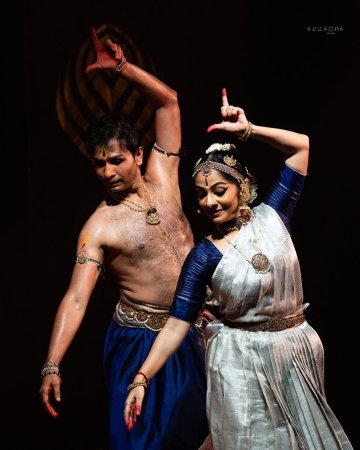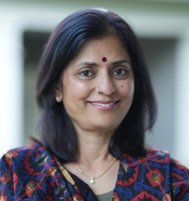
|   |

|   |
An elevating performance by Parvathy Menon and Shijith Nambiar - Anita Vallabh e-mail: anitavallabhofficial@gmail.com Photo: Season Unnikrishnan December 24, 2024 The intention of this review/critique is to highlight the evocative moments in the Bharatanatyam performance by Parvathy Menon and Shijith Nambiar on December 13th, at the eve of the 68th Margazhi Mela at Krishna Gana Sabha. The curtains opened to a smoky, illuminating space, revealing instantly the aesthetic criteria of the performance, utilizing the art of visual presentation to suggest an immersive space - of illusion and illumination. As the soulful voice of Binu Venugopal filled the auditorium, Parvathy and Shijith commenced their performance with a verse from Sri Narayana Guru's kriti: Adu pambe adu pambe ananda koothu kandu adu pambe. They explored the movement of Kundalini shakti as a coiled snake seeking union with Śhiva at the Sahasrara chakra. In the moment of their blissful union, begins Dikshitar's Ananda Natana Prakasham. Seeking to highlight and communicate the idea and philosophical essence of this ever-enchanting song, the two dancers communicated various ideas of Anandam and Prakasham thoughtfully, deliberately eschewing established motifs. Shijith says, while analyzing the word meaning of the song the word 'Prakasham' moved him so deeply that he wanted to bring out the expansiveness of the light of consciousness, within and without. The depth of his research and self-reflection is evident in the choreography and depth of rendition. I was impressed by the resourcefulness and courage to reimagine a Kalakshetra classic.  Shijith Nambiar and Parvathy Menon From there, they moved on to the very famous Nattakurinji varnam by Papanasam Sivan, Swami naan undan. In keeping with the idea of surrender, the duo commenced with the anupallavi, drawing abstract motifs of the various aspects of Siva. A standout moment was the elaboration on the concept of Bhutesa, the creation of the universe, the duality of Shiva-Shakti - of stillness in motion and motion in stillness. Parvathy and Shijith demonstrated exceptional technical proficiency, rhythmic brilliance and emotional depth, seamlessly integrating their skills with a profound comprehension of music, space, and lighting. Their ability to discern visual aesthetics and effectively create dramatic effects is truly remarkable. Another engaging piece was Parvathy's interpretation of Muthu Tandavar's Theruvil varano. Rijesh Gopalakrishnan's delightful play of the kanjira suggesting Lord Shiva's distant approach and his proceeding past an eagerly awaiting Nayika offered a glimpse of the profound effect that can be achieved when there is harmony between vibrations of sound and emotion. The sanchari where the Nayika writes various love notes to Shiva and hands them over to a deer, only to discard them one by one because of their weight was poignantly expressed by Parvathy. Adding to the poignancy, towards the end of the song Shijith as Shiva walks to a sleeping nayika, reads the discarded love notes, affectionately places his hand on her head and leaves. Soon after she wakes up, she looks around at the opened notes and ponders in a mix of wonder and despair if Shiva had indeed come to her. The delicate play of emotions on Parvathy's face suggested the veiled line between the real and the surreal. Indeed, it is only a mature and dedicated artiste who can masterfully bring forth such a nuanced performance. Through the performance followed by Shijith's Eppo varuvaro by Gopala Krishna Bharati and the duo's Chidambaresvara Stotram, Parvathy and Shijith's performance and choreography suggested timelessness and contemporaneity within a traditional framework. In his solo, when Shijith as the devotee plays the mridangam, one was enraptured by the intensity of devotional fervor and selfless surrender that he expressed through angika abhinaya. While their performance exhibits many commendable elements, there are a few considerations that require attention. They should exercise caution in emphasizing the rhythmic and movement aspects of their performance, as this may diminish the emotional impact of the song. A seamless integration of music, rhythm, movement, and expression is essential for an impactful performance. While brilliantly executed, excessive rhythmic permutations and combinations in any given choreography, whether it be a padam, varnam, or tillana, will detract the audience from an immersive experience. Furthermore, they need to pay attention to certain repetitions, such as commencing every song with the anupallavi and excessively employing smoke. Initially, the smoke contributed to the mystical ambiance and enhanced the lighting. However, its repetitive use became distracting. Parvathy and Shijith's artistic vision was rendered ethereal by a stellar cast of musicians and light technician: nattuvangam, Udayshankar Lal; vocal, Binu Venugopal; mridangam, Siva Prasad; violin, Easwar Ramakrishnan; kanjira, Rijesh Gopalakrishnan and lights, Sivan Vengitangu. Overall, their performance combined a soulful exploration of abstract philosophical concepts with virtuosic abhinaya and technique. It makes one rethink the boundaries of possibilities beyond the existing performative parameters. I am reminded of what the artist Saya Woolfalk articulated at the Museum of Art in New Mexico: The idea that we can create collective imaginings together and then actually enact them in the world -- this just might be the place of freedom. Even if it's through fantasizing, even if it's just for a moment, a portal where that imagining can happen, this may be the space where liberation is born.  Anita Vallabh is an Adjunct professor at the University of Hawaii, author, Yoga instructor and dance critic. She lives in Boston, USA. |